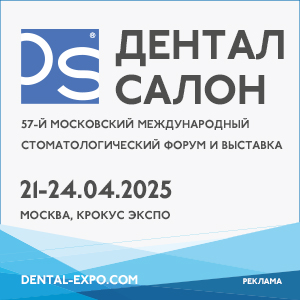DOI:
10.37988/1811-153X_2024_3_155Minimally invasive treatment of enamel defect
Downloads
Abstract
The esthetic disbalance of a smile is an important and integral part of human socialization in life. Popular position is that beautiful smile can be reflection of the successful personality. Also, a smile is a natural reaction of the body to positive emotions, which are necessary for psychological stability. Tooth enamel is a protective layer of hard tooth tissues from external environmental factors and prevents the occurrence of premature carious process. Modern tips, even with minimal vibration during operation, form cavities that go beyond healthy tissues. Thus, the protection of hard dental tissues by minimal invasive dissection and aesthetic restoration of facial appearance is an important problem of modern dentistry. This article presents a clinical case of restoring the integrity of the vestibular surface of the central incisor within the enamel-dentine border (junction) and the aesthetic balance of the smile in a young patient using modern minimally invasive technologies for the preparation of vital teeth. The description of the clinical stages of cavity preparation and layered aesthetic restoration of the frontal tooth, as well as dynamic monitoring after 24 hours, 1, 3, 6 months and 1 year using modified Ryge‘s criteria. The data obtained proved the possibility of using minimal invasive preparation to work with the included enamel defect.Key words:
enamel defect, abrasive preparation, aesthetic balance, smile, restorationFor Citation
[1]
Kochurova E.V., Kudasova E.O., Risovannaya O.N., Seferyan K.G., Polyakova O.L. Minimally invasive treatment of enamel defect. Clinical Dentistry (Russia). 2024; 27 (3): 155—160. DOI: 10.37988/1811-153X_2024_3_155
References
- Lobach O.I., Nikolenko V.N., Lapina N.V., Kochurova E.V., Risovannaya O.N., Skorikov V.Yu. Impact of aesthetic component of dental health on the quality of life of young patients. Kazan Medical Journal. 2019; 3: 416—421 (In Russian). eLIBRARY ID: 37636569
- Ozhgikhina N.V., Zakirov T.V., Kiselnikova L.P. Need for treatment of enamel hypoplasia of the first permanent molars in children. Pediatric Dentistry and Profilaxis. 2019; 4 (72): 26—30 (In Russian). eLIBRARY ID: 42490588
- Masterova I.V., Lomiashvili L.M., Pogadaev D.V., Gabrielian I.K., Mikhaylovskiy S.G., Postolaki A.I. Improvement of methods of morphometric studies of teeth. Clinical Dentistry (Russia). 2022; 1: 6—12 (In Russian). eLIBRARY ID: 48156183
- Gazhva S.I., Manukyan A.G., Teterin A.I., Yanysheva K.A., Yakubova E.Y. Structural and microelemental changes in enamel under the influence of various methods of preparation. Clinical Dentistry (Russia). 2023; 1: 24—31 (In Russian). eLIBRARY ID: 50465565
- Nakano E.L., de Souza A., Boaro L., Catalani L.H., Braga R.R., Gonçalves F. Polymerization stress and gap formation of self-adhesive, bulk-fill and flowable composite resins. Oper Dent. 2020; 45 (6): E308-E316. PMID: 32516396
- Erhardt M.C.G., Goulart M., Jacques R.C., Rodrigues J.A., Pfeifer C.S. Effect of different composite modulation protocols on the conversion and polymerization stress profile of bulk-filled resin restorations. Dent Mater. 2020; 36 (7): 829—837. PMID: 32446504
Downloads
Received
February 14, 2024
Accepted
August 14, 2024
Published on
October 2, 2024











